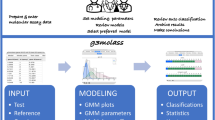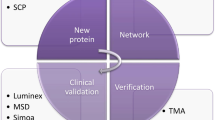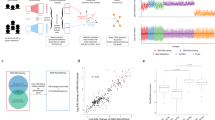Abstract
For microarrays, the transition from research to clinical and diagnostic applications is well underway. Microarrays use a range of specific probes that are immobilized in known locations on a support matrix; this technique can measure levels of specific DNA, RNA and proteins, as well as carbohydrates and lipids. It is anticipated that analysis of these levels will lead to identification of biomarkers for the diagnosis, treatment and prognosis of a wide range of diseases. So far, this type of analysis has been particularly useful in clinical oncology, but the technology is being actively and successfully explored for diseases such as diabetes, endocrine tumors and endocrine modulators of tumors. There are now many commercial sources of microarrays, which have robust quality-control procedures in place. Progress will be enhanced when biomarkers can be established, statistical approaches can be refined and when we better understand the interactions of genes and of particular gene loci in disease progression.
Key Points
-
Microarrays provide the opportunity for analysis of large numbers of polynucleotides (DNA and mRNA) or proteins simultaneously
-
Microarrays allow genome-wide, transcriptome-wide, and proteome-wide analysis to be carried out for the identification of biomarkers and their potential applications
-
Biomarkers in the form of DNA mutations, expression profiles, and protein levels provide valuable data in basic and preclinical research, as well as diagnosis, treatment option assessment and prognostic determination
-
Microarray analysis has generated important information about the molecular basis of diabetes, implicating components of the mitochondrial ATP synthesis pathway
This is a preview of subscription content, access via your institution
Access options
Subscribe to this journal
Receive 12 print issues and online access
$209.00 per year
only $17.42 per issue
Buy this article
- Purchase on Springer Link
- Instant access to full article PDF
Prices may be subject to local taxes which are calculated during checkout



Similar content being viewed by others
References
Southern EM (2000) Blotting at 25. Trends Biochem Sci 25: 585–588
Southern E et al. (1999) Molecular interactions on microarrays. Nat Genet 21 (Suppl 1): S5–S9
Frei E et al. (1985) Cloning of the extra sex combs gene of Drosophila and its identification by P-element-mediated gene transfer. EMBO J 4: 979–987
DeLorenzi M et al. (1988) Evidence that the Abdominal-B r element function is conferred by a trans-regulatory homeoprotein. EMBO J 7: 3223–3231
Webb G et al. (1990) Location of gyrA on the physical map of the Escherichia coli chromosome. J Bacteriol 172: 6617
Brown DM (1993) A brief history of oligonucleotide synthesis. Methods Mol Biol 20: 1–17
Fodor SP et al. (1993) Multiplexed biochemical assays with biological chips. Nature 364: 555–556
NCBI GenBank Overview [http://www.ncbi.nlm.nih.gov/Genbank/] (accessed 24 April 2007)
Schena M et al. (1996) Parallel human genome analysis: microarray-based expression monitoring of 1000 genes. Proc Natl Acad Sci USA 93: 10614–10619
White JC and Stryer L (1987) Photostability studies of phycobiliprotein fluorescent labels. Anal Biochem 161: 442–452
Ernst LA et al. (1989) Cyanine dye labeling reagents for sulfhydryl groups. Cytometry 10: 3–10
Minsky M (1988) Memoir on inventing the confocal scanning microscope. Scanning 10: 128–138
Norris AW and Kahn CR (2006) Analysis of gene expression in pathophysiological states: balancing false discovery and false negative rates. Proc Natl Acad Sci USA 103: 649–653
Kutlu B et al. (2004) New approaches for in silico identification of cytokine-modified β cell gene networks. Ann NY Acad Sci 1037: 41–58
Matsunaga T and Muramatsu MA (2005) Knowledge-based computational search for genes associated with the metabolic syndrome. Bioinformatics 21: 3146–3154
Dufva M and Christensen CB (2005) Diagnostic and analytical applications of protein microarrays. Expert Rev Proteomics 2: 41–48
LaBaer J and Ramachandran N (2005) Protein microarrays as tools for functional proteomics. Curr Opin Chem Biol 9: 14–19
Angeloni S et al. (2005) Glycoprofiling with micro-arrays of glycoconjugates and lectins. Glycobiology 15: 31–41
Kanter JL et al. (2006) Lipid microarrays identify key mediators of autoimmune brain inflammation. Nat Med 12: 138–143
Phizicky E et al. (2003) Protein analysis on a proteomic scale. Nature 422: 208–215
Bell J (2004) Predicting disease using genomics. Nature 429: 453–456
Lee TI and Young RA (2000) Transcription of eukaryotic protein-coding genes. Annu Rev Genet 34: 77–137
Lemon B and Tjian R (2000) Orchestrated response: a symphony of transcription factors for gene control. Genes Dev 14: 2551–2569
Emerson BM (2002) Specificity of gene regulation. Cell 109: 267–270
Matsuzaki H et al. (2004) Genotyping over 100,000 SNPs on a pair of oligonucleotide arrays. Nat Methods 1: 109–111
Bejjani BA et al. (2005) Array-based comparative genomic hybridization in clinical diagnosis. Expert Rev Mol Diagn 5: 421–429
van Steensel B and Henikoff S (2003) Epigenomic profiling using microarrays. Biotechniques 35: 346–357
Ragoussis J et al. (2006) Matrix-assisted laser desorption/ionisation, time-of-flight mass spectrometry in genomics research. PLoS Genet 2: e100
Wang SM (2007) Understanding SAGE data. Trends Genet 23: 42–50
Baggerman G et al. (2005) Gel-based versus gel-free proteomics: a review. Comb Chem High Throughput Screen 8: 669–677
Yuan M and Kendziorski C (2006) A unified approach for simultaneous gene clustering and differential expression identification. Biometrics 62: 1089–1098
Mocellin S and Rossi CR (2007) Principles of gene microarray data analysis. Adv Exp Med Biol 593: 19–30
Hanai T et al. (2006) Application of bioinformatics for DNA microarray data to bioscience, bioengineering and medical fields. J Biosci Bioeng 101: 377–384
Mount DW and Pandey R (2005) Using bioinformatics and genome analysis for new therapeutic interventions. Mol Cancer Ther 4: 1636–1643
Carella M et al. (2003) Nanotechnologies and microchips in genetic diseases. J Nephrol 16: 597–602
Boel E et al. (2000) Modulation of metabolism through transcriptional control has created new treatment opportunities for type 2 diabetes. Curr Pharm Biotechnol 1: 63–71
Nadler ST and Attie AD (2001) Please pass the chips: genomic insights into obesity and diabetes. J Nutr 131: 2078–2081
Perfetti R and D'Amico E (2003) The contribution of gene profile analysis to the design of a molecular approach to treat diabetes in humans. Diabetes Technol Ther 5: 421–423
Bell GI and Polonsky KS (2001) Diabetes mellitus and genetically programmed defects in β-cell function. Nature 414: 788–791
Odom DT et al. (2004) Control of pancreas and liver gene expression by HNF transcription factors. Science 303: 1378–1381
Song JY et al. (2005) Diagnosis of HNF-1α mutations on a PNA zip-code microarray by single base extension. Nucleic Acids Res 33: e19
Rasschaert J et al. (2003) Global profiling of double stranded RNA- and IFN-γ-induced genes in rat pancreatic β cells. Diabetologia 46: 1641–1657
Webb GC et al. (2000) Expression profiling of pancreatic β cells: glucose regulation of secretory and metabolic pathway genes. Proc Natl Acad Sci USA 97: 5773–5778
Scearce LM et al. (2002) Functional genomics of the endocrine pancreas: the pancreas clone set and PancChip, new resources for diabetes research. Diabetes 51: 1997–2004
Bernal-Mizrachi E et al. (2003) Gene expression profiling in islet biology and diabetes research. Diabetes Metab Res Rev 19: 32–42
Aune TM et al. (2003) Gene expression profiles in human autoimmune disease. Curr Pharm Des 9: 1905–1917
Gunton JE et al. (2005) Loss of ARNT/HIF1β mediates altered gene expression and pancreatic-islet dysfunction in human type 2 diabetes. Cell 122: 337–349
Mootha VK et al. (2003) PGC-1α-responsive genes involved in oxidative phosphorylation are coordinately downregulated in human diabetes. Nat Genet 34: 267–273
Subramanian A et al. (2005) Gene set enrichment analysis: a knowledge-based approach for interpreting genome-wide expression profiles. Proc Natl Acad Sci USA 102: 15545–15550
Patti ME et al. (2003) Coordinated reduction of genes of oxidative metabolism in humans with insulin resistance and diabetes: potential role of PGC1 and NRF1. Proc Natl Acad Sci USA 100: 8466–8471
Sreekumar R et al. (2002) Gene expression profile in skeletal muscle of type 2 diabetes and the effect of insulin treatment. Diabetes 51: 1913–1920
Whitfield ML et al. (2006) Common markers of proliferation. Nat Rev Cancer 6: 99–106
Sommer A and Haendler B (2003) Androgen receptor and prostate cancer: molecular aspects and gene expression profiling. Curr Opin Drug Discov Devel 6: 702–711
Eigl BJ et al. (2005) Timing is everything: preclinical evidence supporting simultaneous rather than sequential chemohormonal therapy for prostate cancer. Clin Cancer Res 11: 4905–4911
Novak K (2006) Where the chips fall. Nat Med 12: 158–159
Xu XQ et al. (2005) Gene expression profiling to identify oncogenic determinants of autocrine human growth hormone in human mammary carcinoma. J Biol Chem 280: 23987–24003
Hayashi S (2004) Prediction of hormone sensitivity by DNA microarray. Biomed Pharmacother 58: 1–9
Jaeger J et al. (2005) Early diagnostic marker panel determination for microarray based clinical studies. Stat Appl Genet Mol Biol 4: Article9
Carling T (2005) Multiple endocrine neoplasia syndrome: genetic basis for clinical management. Curr Opin Oncol 17: 7–12
Kim IJ et al. (2002) RET oligonucleotide microarray for the detection of RET mutations in multiple endocrine neoplasia type 2 syndromes. Clin Cancer Res 8: 457–463
Bowtell DD (1999) Options available—from start to finish—for obtaining expression data by microarray. Nat Genet 21: 25–32
Cheung VG et al. (1999) Making and reading microarrays. Nat Genet 21: 15–19
Haab BB et al. (2001) Protein microarrays for highly parallel detection and quantitation of specific proteins and antibodies in complex solutions. Genome Biol [doi: 10.1186/gb-2001-2-2-research0004]
Hirschhorn JN and Daly MJ (2005) Genome-wide association studies for common diseases and complex traits. Nat Rev Genet 6: 95–108
Horikawa Y et al. (2000) Genetic variation in the gene encoding calpain-10 is associated with type 2 diabetes mellitus. Nat Genet 26: 163–175
Morley M et al. (2004) Genetic analysis of genome-wide variation in human gene expression. Nature 430: 743–747
Author information
Authors and Affiliations
Corresponding author
Ethics declarations
Competing interests
The authors declare no competing financial interests.
Rights and permissions
About this article
Cite this article
Vlacich, G., Roe, C. & Webb, G. Technology Insight: microarrays—research and clinical applications. Nat Rev Endocrinol 3, 594–605 (2007). https://doi.org/10.1038/ncpendmet0580
Received:
Accepted:
Issue Date:
DOI: https://doi.org/10.1038/ncpendmet0580



